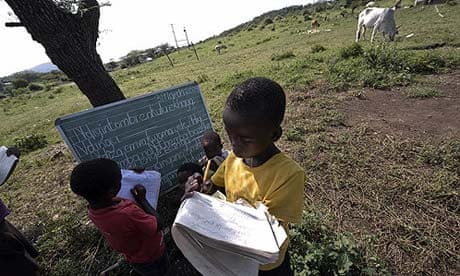Developing countries are unlikely to meet UN targets for improving education because of the widespread marginalisation of students' first languages, which results in teaching being delivered in languages that
children struggle to understand or to use effectively.
This is the stark warning issued by the UK charity Save the Children and the Centre for British Teachers (CfBT), the international not-for-profit education consultancy, in a joint report published last month.
The report, called Language and Education: the Missing Link, claims that failure to provide schooling in the language that children are most familiar with – the one that they speak at home – is a root cause of education failure, leading to children dropping out of school early and resources being wasted because rates of attainment are slowed.
"Not being able to understand the language used for teaching is a major reason why children drop out of school or fail to do well," said Helen Pinnock, Save the Children's education adviser and one of the report's authors. "It contributes to millions of children missing out on a decent education simply because they can't speak the school language."
The report calls on education policymakers to take heed of a growing body of research that highlights both how an unfamiliar language of instruction can hold back learning and the advantages that can be achieved by investing in multilingual education provision.
It also urges international donor agencies to make delivery of mother-tongue teaching a focus of their education projects and to re-evaluate funding that leads to the promotion of national or international languages, such as English, over local ones.
It is not just children in developing countries who are being denied access to schooling in their home language. The report quotes research that estimates that in the US up to 18% of the population fall into this category. It also claims that children in most Arabic-speaking countries are in effect learning in a second language because the varieties of Arabic they speak at home are often very different to the classical Arabic used in classrooms.
But it is in countries where numerous languages are spoken, often as a result of ethnic diversity, that the impact of using a single language for education can be most severe on young people's educational achievement and their economic success.
The report suggests that 54 million children are currently not attending school in countries classified as "highly linguistically fractionalised" and these countries account for 58% of the global primary-school aged population.
"Not only does teaching and learning in a second language result in dropout from school altogether, but for those children that manage to stay in education, it has a strong negative impact on education achievement," the report said.
Among the research quoted to support this claim is the Trends in International Mathematics and Science Study (Timss) conducted in more than 40 countries, which found that children assessed in a language that was not the one they spoke at home performed worse in their maths and science tests.
The report stops short of claiming that teaching in children's home language will automatically lead to better learning outcomes. Instead it says that other interventions to improve education provision will be significantly weakened unless first-language teaching is in place.
The report also stresses that a move to mother-tongue teaching need not undermine the learning of other languages. It advocates that teaching is restructured to deliver as much of the curriculum as possible in the most familiar language from early primary level. The teaching of a second language, in most cases the main "national" language, is introduced at upper primary level, when children have more advanced learning skills and are likely to acquire a second language more successfully. This approach is called mother tongue-based multilingual education.
But persuading governments to change their policies and invest in adapting school curricula and materials – estimated to add up to 5% to education budgets – will be an uphill task, the report concedes.
It acknowledges that many governments impose a single language in schools, particularly in ethnically and linguistically complex countries, because they believe that it helps to create social cohesion and offers minority groups greater access to economic opportunity.
But the report gathers evidence that the denial of first-language education is often a contributing factor in inter-ethnic conflict. A new approach to school languages could diffuse tensions and "create fluency in the language of nationhood", it says.
The authors of the report are also realistic about the strength of aspiration among some parents for their children to learn "high prestige" international languages such as English, and who believe that they will speed up acquisition by enrolling their children in schools that teach in these languages. Better communication of the benefits of mother-tongue teaching will be needed to persuade parents to support this approach, they say.
The report claims that evidence of poor attainment from the Timms survey was instrumental in persuading the Malaysian government this year to drop its policy of teaching all maths and science classes in English and return to instruction in Bahasa-Malay.
The report is critical of donor agencies for not incorporating mother-tongue schooling into their strategies. "Few donors appear to be promoting good practice where the risk of not taking action is worst. A significant scaling up of awareness, investment and action is needed to prevent language of instruction dragging down efforts to achieve international commitments to deliver basic education," the report noted.
